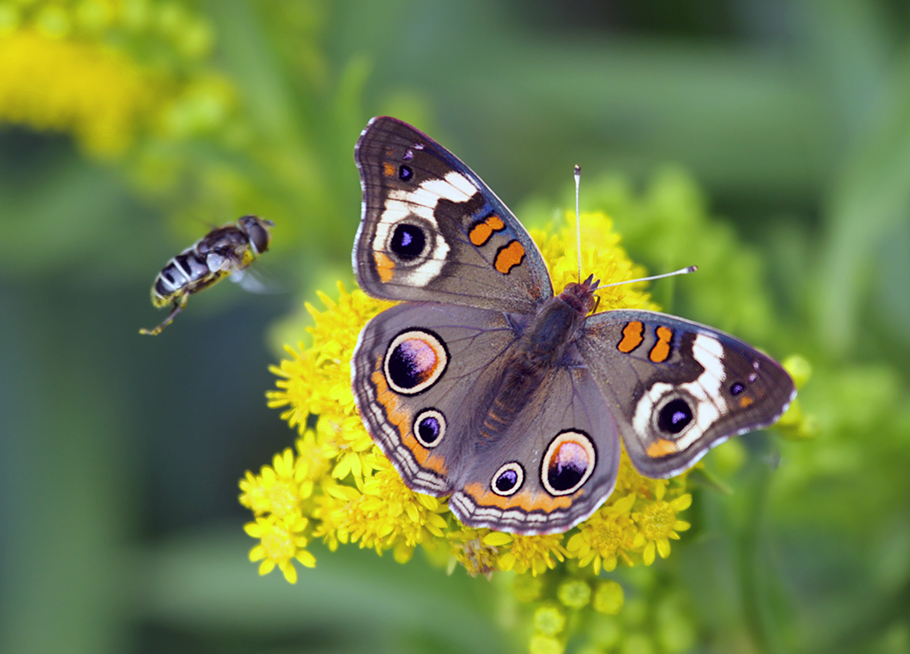
Using Regenerative Practices to Support and Protect Pollinators
by CRARS staff member Sheryl Karas. M.A.

Bees and other pollinators like moths, flies, butterflies, birds, ants and bats are essential for pollinating approximately 30% of the world’s food and fiber supply(opens in new window). In the United States, over 100 crop plants depend on these pollinators. Without them we couldn’t produce many of the fruits, nuts, and vegetables Americans eat every day. It is estimated that these crops represent about $24 billion to the U.S. economy(opens in new window), and that does not include the meat and dairy products produced from bee-pollinated forage and hay crops.
Unfortunately, pollinators have been in a serious decline in recent years. The United States Department of Agriculture(opens in new window) (USDA) cites invasive pests and diseases (such as Varoa mite infestations), exposure to pesticides and other chemicals, loss of habitat, loss of species and genetic diversity, and changing climate as the primary causes. Many species of butterflies, moths, and native bees are now rare or fully extinct.
Farmers often balk at the potential expenses involved in rectifying this situation, but they also have the most to gain. Recent studies have shown that declines in native bee populations directly correlates to declines in crop yields(opens in new window), while creating bee habitat(opens in new window) can increase yields enough to pay for itself in just a few years. But there are more reasons to work with increasing the number of bees that visit your farm beyond that. Many of the practices that support and protect bees are also important for soil health, reducing soil erosion, and increasing carbon sequestration. With government programs designed to help pay for these expenses, farmers can start seeing profitable gains even quicker. Start with the Environmental Quality Incentives Program (EQIP) program(opens in new window) through the USDA Natural Resources Conservation Service. In California, you can also apply for funding through the California Department of Food and Agriculture’s Pollinator Habitat Program(opens in new window). Project Apis m’s Seeds for Bees(opens in new window) program can provide free or subsidized seeds for bee-attracting cover crops.
How Regenerative Practices Can Help
Pollinator habitat can be created in multiple ways either adjacent to crops in hedgerows or intermixed between crop rows. It is also effective to plant a field of pollinator-friendly cover crops as part of a regular crop rotation and to create permanent wildlife and pollinator habitat on land not well-suited for crop production. Riparian buffers, for example, can serve multiple purposes of reducing soil erosion and nutrient run-off into waterways while increasing biodiversity and property aesthetics.
You will also want to incorporate practices that not only attract bees but keep them from being harmed once they arrive. Pesticides are the biggest danger to insect pollinators and birds. It is also important to avoid choices that might disturb nesting areas or eliminate their primary food source (flower nectar) too early in the year. Best choices include:
- Minimize tillage to preserve nesting habitats.
- Create permanent habitat in the form of hedgerows, windbreaks, and riparian buffers.
- Intercrop with flowering plants like clover or vetch.
- Cover crop with mixed species of plants that provide flowers throughout the year.
- Avoid the use of pesticides or practice integrated pest management.
- Terminate cover crops past peak blooming with as little soil disturbance as possible (use roller crimping, for example).
- Leave crop residue in place to protect beneficial insect eggs and also provide a soil-protecting mulch and cover.
- Use more than one pollinator-friendly practice to provide the versatility needed for the farmer without destroying bee habitat (for example, cover crops that may need to be terminated or rotated along with permanent conservation plantings of native species).
